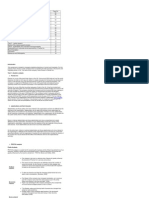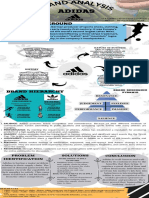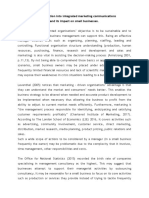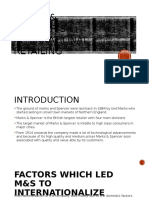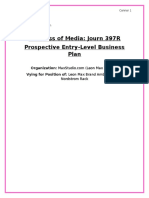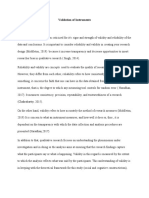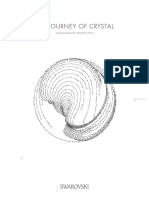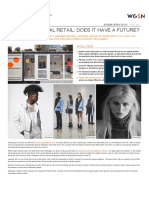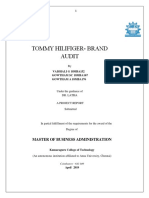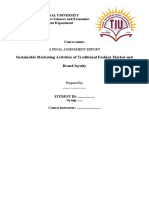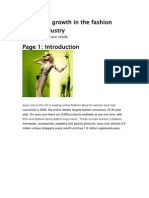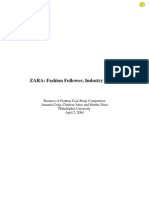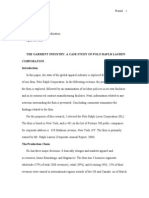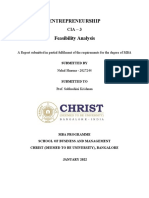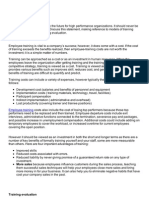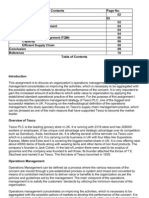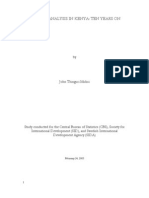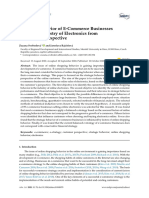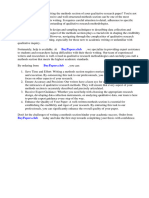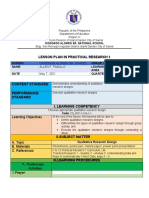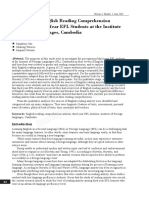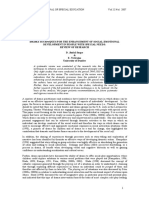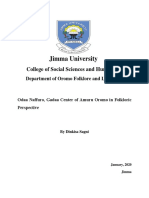Impact of Brand Image On The Clothing Buying Behavior - A Case Study of Marks & Spencer
Impact of Brand Image On The Clothing Buying Behavior - A Case Study of Marks & Spencer
Uploaded by
Al AminCopyright:
Available Formats
Impact of Brand Image On The Clothing Buying Behavior - A Case Study of Marks & Spencer
Impact of Brand Image On The Clothing Buying Behavior - A Case Study of Marks & Spencer
Uploaded by
Al AminOriginal Description:
Original Title
Copyright
Available Formats
Share this document
Did you find this document useful?
Is this content inappropriate?
Copyright:
Available Formats
Impact of Brand Image On The Clothing Buying Behavior - A Case Study of Marks & Spencer
Impact of Brand Image On The Clothing Buying Behavior - A Case Study of Marks & Spencer
Uploaded by
Al AminCopyright:
Available Formats
Research Title Impact of Brand Image on the Clothing buying behavior- A Case Study of Marks & Spencer
Abstract This research will explore and investigate the impact of branding on consumer behavior by conducting a case study on M & S. In the fashion industry changes occurred very rapidly that companies sometimes coudild not balance with this change. Due to the changing nature of the business environment of this industry, the firms that operate in this industry always remain ready for adopting changes. Consumer buying behavior in this industry is also very dynamic and changes with new trend. Significance of brand image was focused by many marketing genius and they suggested to study on the concept of brand equity. A steady brand image can create a special uniqueness in a market, increase the profitability, and enhance a mediatory correspondences and it boost up the options of brand expansion. This research will be conducted by following a mixed research method (combination of qualitative and quantitative methods). The primary data will be collected taking semi-structured interview of the selected respondents. The target sample size is 103 (100 customers and 2 sales managers and 1 marketing manager). In conclusion, as this paper is investigating the impact of branding over the customers it will help the business related organizations as well the student studying with this topic. The researcher believes that it will help in exploring new dimension for this type of study in future.
Table of Contents Contents Chapter 1 Introduction Page No. 01
1.1Research Background
1.2 Purpose of the Study 1.3 Research Aim and Objectives 1.4 Research Questions to be answered 1.5 Rationale for chosing this Study 1.6 Background of the case company (Marks and Spencer) Chapter 2 Literature Review 2.1 Introduction 2.3 Brand 2.3 Brand Equity 2.4 Consumer buying behavior 2.5 Brand Image and Buying Behavior 2.6 Summary Chapter-3 Research Methodology
01
02 02 03 03 03 04 04 04 04 06 08 11 12
3.1 Introduction 3.2 Research Philosophy 3.3 Research Method 3.4 Research Strategy 3.5 Research Approach
12 12 12 13 13
3.6 Data Collection Method & Tool
3.7 Semi Structured Interview 3.8 Sampling Technique and Sample Size 3.9 Data Analysis & Presentation Method
13
13 14 14
3.10 Timescale & Research Planning
3.11 Validity 3.12 Reliability 3.13 Ethical Considerations Conclusion References
14
15 15 15 15 16-17
Chapter 1 Introduction
1.1Research Background
This study is to explore the impact of brand image on consumer behavior by conducting a case study on M & S. Clothing industry is the most dynamic nature industry. In this industry changes occurred very rapidly that companies sometimes coudild not balance with this change (Passariello, 2008; Rohwedder & Johnson, 2008). Due to the changing nature of the business environment of this industry, the firms that operate in this industry always remain ready for adopting changes. Consumer buying behavior in this industry is also very dynamic and changes with new trend. Due to low switching cost, consumer loyalty in this industry is quite volatile. One of the ways to retain consumers for a long time is to create very strong brand image. Therefore branding plays a very crucial role in this industry and it has significant impact on the buying behavior of the consumers in this industry. The purpose of this research is to show how consumer buying behavior in this dynamic industry is affected by the brand image of the companies operating in this industry. Gucci, Fendi, Prada, Armani, D&G and Zara apart from M & S- all of these firms have their respective brand image and this brand image is reflected in their reputation and size of loyal customer base. Brand image helps these firms in this industry to capture customers and generates a loyal customer base in the long run. Brand image basically has significant influence on the behavior of the customers of these firms in this industry. Since brand image has huge impact on the buying behavior of the customers therefore understanding the magnitude of this impact is very crucial. In this research the researcher will make an attempt to investigate the impact of brand image on the consumer buying behavior. To conduct this research, leading fashion house M & S is selected for analytical purpose. The researcher will conduct this research on Covent Garden branch of M & S which is located in 107 - 115 Long Acre, Covent Garden, London. Since the outcome derived from this research will have significant implicational
importance therefore this research will be important not only for the individuals who would like to work in this industry in future but also for the companies that operate in this industry. To make a brand strong it needs to make the product unique. Strong brand image increases profitability, it enhances opportunity to expand the maket opportunity. Brand represents any product or service that the corresponding product boost up the image (Aaker, 2006). Before geeting any expefricne of an product a consuemr do not get any information about a product. So after consumption of aproduct it is measured whether product is consumable or rebuy-able. Consumes build knowledge on a product or on service depending on prior experience of a product or from the third parties that have already consumed it. To sustain a brand and its iamge it is required to have importnce in its perfroamnce and the ovearall perfoamce should be consumer centric as the cosnumers can find out expected services from the product. A brand has significant role in the products features and market situation. Researchers have shown some studies ont eh Brand image building. They proved the genious of brand depend on brand equity. (Keller, 2006) Their conception is on the organisations profitability and capability on their revenues.
1.2 Purpose of the Study The purpose of this research is to show how consumer buying behavior in this dynamic industry is affected by the brand image of the firms operating in this industry. 1.3 Research Aim and Objectives The aim of this research is to identify the impact of branding on consumer behavior in the clothing industry. To achieve the research aim the researcher will conduct a case study on Covent Garden branch of M & S in line with the following research objectives. To analyze the main characteristics of consumer behavior in clothing industry. To investigate the impact of brand image on consumer buying behavior from the perspective of M & S. To explore the impact of branding in creating loyal customer base for the firms in clothing industry by analyzing the situation of M & S.
1.4 Research Questions to be answered The following research questions will be answered through this studyWhat are the impacts of brand image on the buying decision of the consumer? What factors influence consumers when they buy clothing of a certain brand in the fashion industry? How does branding help create loyal customers for the organization? 1.5 Rationale for chosing this Study There is an proverb that customers are always right and they are God for doing a business. Each and every busniess organization must emphasize on this concept. Whatever policy or startegy is, they always try to focus this concept mostly in their business. So, the experimentation on consumers is really very important for conducting a business. Blackwell et al., (2006, p.-10) stated that the overall activities of consumers plays a vital role to manipulate the financial condition of a country. Consumers like to purchase their required products and services from famous outlets. This study will provide an overall clear idea about the behavior of consumers. 1.6 Background of the case company (Marks and Spencer)
Marks and Spencer is one of the largest superstores of UK. It sells foods, clothes gifts and a home furnishing with the trademark of St. Michael. It is running its business as a normal retailer in UK, Europe, the Americas and Far East. In 1884, M&S started its business as a small shop for the first.
Chapter 2 Literature Review
2.1 Introduction In this chapter the researcher has explained the previous literatures related to the brand image and consumer buying behavior. At first concept of brand is defined and then brand equity is explained.
2.2 Brand Brand is refers to logo, symbol, name, character that represents any product, service, place, person, experience or ideas. It is intangible aspect of a product which is not measured through mathematical framework rather can be imaged though how the consumers are getting it to their buying behavior. Anything distinguishable is brand; if a thong is not distinguishable it is not brand. Brands important are categorizes as following:
2.3 Brand Equity Brand equity is built through awareness building and promotional activities, which Keller (2011, p. 20) suggested that strong awareness building activity through promotional activities are way of getting brand equity. It is also explained in a way that how many days a consumers were attached with the brand, it measures the aspects of the positive side of the brand. According to Bello and Holbrook (2011), Brand equity adds extra value with a product and need to distribute the values properly with appropriate appeal of the goods or services.
A. Brand Awareness Brand equity is formed thorough brand awareness campaign and the brand awareness campaign is full of promotional campaign with respect to the brands core elements. The core concept of the awareness program is to simply call and recalling the consumers about the product, service and other sequential matters (Aaker, 2011, p. 25). Consumers knowledge on brand can be built thorough the promotional ideas and action. These ideas are not alone the way of promotional it can include new ideas of adding innovative consumers attention initiatives. Brand awareness is the major factor in the significant way of communication and information management of the brand. Product information is very important for both the consumers and the buyers, the way of communication can best accommodate the consumers to get appropriate knowledge on the product. Consumers are the facilitator of the product they are the main target of the brand awareness program. Te program is enhanced to have a rank of the product on the consumerism mind (Nedungadi, 2008, p. 263).
B. Perceived Quality What consumers expected and what they found from a brand is called perceived quality of a product. Usually consumers expect a product which tentatively can measure the impact of their demand. But not all the goods can satisfy their demand; it is happed because of gap in the expectation and produced service. Perceived quality is the measurement of the product which is perceived by consumers. Sending the message to the consumers and building the information in way those constraints produces more information in the minds of the consumers (Delong, 2011).
C. Brand Loyalty Brand loyalty is one of the major key components of measuring brand equity. A brand established with some hypothetical perspective and consideration. So we can say the brand is made to make impact in the market. The market share and market profitability is measured by the brand loyalty, how the brads are evaluated by the consumers are key phenomena in brand loyalty measurement. How consumers trust the brand is also the way of measurement of the brand.
D. Brand Association Brand associations are some elements which are included in brand equity. A brand can be associated with some phenomenon. These can be related to features, quality, service uniqueness and other customers satisfaction initiatives. Brand associations are the precise view of brands which are pictured in the mind of the customer before choosing a product (Asker, 2011). Brand associations have significant impartial relationship with the brands name as it is visualized when consumers choose it when it is consumed. According to Keller (2011, p.28) brands associations are the depiction of the brands and these things are the material and nonmaterial component of a company or an organization. When a product is chosen by the consumer it should be kept in mind that these associations regarding brands are also implement personality of the consumers. Brand associations are the signs of a product, with the guarantee to fulfill
consumers needs and demands.
2.4 Consumer buying behavior Consumption behavior is the households attitudes towards specific product. Before building a brand it is needed to measure the impact of the brand according to the available resources and efforts. According to Schiff man and Karuk (2011) consumer behavior studies the efforts and time constraints of the consumers when they choose a product.
Models of consumer behavior There are several component and models to measure the impact of consumer behavior on choosing a product. These studies are done for measuring the consumers behavior and such behavior are regarding pre-purchase and post-purchase.
A generic model of conumers buyin deciosn process is given below:
Figure: consumer buying process (behavior) process (source: own)
Stage one- need recognition Need recognition is the first stage in the consumers buying behavior process. When any person feel deprivation of anything then need is occurred and such need is converted to demand if the person gets money to satisfy and it is supported by the society (Solomon et al., 2011). Need recognition is the social process that is occurred to everyone as need of anything is raised. When need is recognized they search for its solution and thus the need recognition urges the marketers to produce new product in the market. Needs may be classified into two major parts, including emotional and functional. All functional needs are satisfied by the material product when emotional products can be satisfied by the services and other components.
Stage two - The search of information When a customers need is recognized they try to find the appropriate solution which can be product or service. The second stage include finding out the products information which can satisfy the customers needs (Moorthy et al., 2010). Customers search the information for the need requires some techniques which can be classified in to several individual factors.
Stage three- the pre-purchase evaluation Before purchasing the product or trialing the service the consumers tries to get different products and then compare the brands with others and then decide to buy. Customers values some requires features and utilities in the product which are filled in the product or service (Kotler et al., 2010). The product is also considered in several aspects like as size, price, quality and stores.
Stage four When a person or customer takes the purchase decision it takes a much effort for the retailer. Because a retailer needs to make some agreements with the consumers, also need to fulfill the needed presentation of the product. According to Blackwell et al., (2010) it is quite apparent that the earlier stages are helpful in making purchasing decision. But in this situation the consumers can be influenced by the sales person behavior, store attractiveness and so on.
Stage five, and six and It is the final stage when the customer ultimately takes the decisions on purchasing. After a lot of products and service centric measurements and stages of consumers evaluation get maturity in buying behavior. The consumers take the decision of buying. If any product can satisfy consumers need and demand they are then again make decision to have a new buying decision from them. A satisfied customer can play as role of advertiser; if he or she gets satisfaction then he/she influences others (Blackwell et al., 2010). Customers are needed to sustained in the long run and for these companies need to make more initiatives to induce them to re-buy.
2.5 Brand Image and Buying Behavior According to American Marketing Association, brand image is the process of building the mental set up on the brand. The process of branding and building buying behavior is also considered to as making of products differently. Customer thinking about a product can be imitated if the product is made per the consumers requirements. Marketing programs are produced to construct such connection with the consumers and other target groups (Keller, 2011, p. 35). There are no specific brand image strategies and trustworthy categories of building brand image. But it cannot limit the chance of describing perspectives of brand image. There are several classes of disadvantages of brand image as the studies are prepared (Dobni and Zinkhan, 2010). Brand image flows of consumers and they induce people to buy more. The disadvantages of brand image are if the consumers are not fulfilled properly. The significance of the brand image cannot be overstated but the extra perception and valuation of any brand induce them to restrict from the relevance. There are some elements which can be stated for credited names, presentation of values, and apparent features. According to Pohlman and Mudd (2011, p. 24) brands posses symbolic utility which possess the demonstration of intellectuality and unique product features. There are many things which can represent the brands and brands identity. According to Levy (2010, p.35) Each and every brand has some points which can identify and declare some common brand image eroding tools. Brand is representation of what the consumers want from the organizations. Images are not alone the criteria of any brand to be distinguished, there are some bodily found factors are emphasized by some researchers. It is significant that, according
to Dobni and Zinkhan (2010, p. 45) the most recognized signs of the brand included brands tasks, object appearance, public relations, referrals and so on. Some researchers have showed some few aspects brand image and brand individuality and these individual factors are building the products and services as brand personality. Brands are considering are like as personality (Hendon and Williams; 2011, p. 67). The brands structure and infrastructure is like a body of human being and it embodies some common characters of an individual. These characters are repeatable (Dobni and Zinkhan; 2010, p. 45). There are some pompous theory and research study in this respect of brand which simply include the features and correlation among the variables of the brands and other aspects. They possess some sight on the meaningfulness of the brand imagery and ridicule in the brand management. Good individualistic and personality oriented brands are many other aspects of the brand and these things are common in the presented studies. An explanation of the continuing theory of the brand management can have further description and they may rest imposition on the imagery of the brand. Overall research study has shown some of the others letters of emotional and other functional features of a brand. Peoples cognition on a brand finally imposes the sales and revenue collection by the firms (Swartz; 2010, p. 34). Some projection in this regard has minimized the significance of less brand imagery.
To add extra benefit brands require some initiatives to make the strong brand image. It is important for a brand to have the strong image on the product and the product has to have the image of branding and deliberation of values to its customers. Brands are now including several aspects like as manner, constructs and thoughts of opportunity and so on. (Dobni and Zinkhan, 2010, p. 45) The brand is combinations of some other perspective of realism. The realities a brand carries cannot be overlooked. Their thoughts, manners and addition of opinions are considered by the brand building tools (Levy; 2011, p. 36). The absolute picture of a brand is essential in building the brand. The circumstances of the means, measures of a brand and distinguishable intimidation system in a brand can make help the brand management to take positive action on the prospects. The distinguishable focuses on the elements of the brand can help you to make a diverse promotional and cultural identity (Reynolds and Gutman, 2010, p. 78). The sustainable variety and pinpoints of the brands are the measurement of an image of a product and the prospects and values can be differentiated by the different brand images. The brand image building activity and the major elements of brands can facilitate to have a calculated size of the picture of brand (Pohlman and Mudd; 2010, p. 34). This is well established that the ideal and competitive strength of a brand and other scenario of a brand inherit some ideal points and promotional points. The additional and actual points of the brands are always distinguishable.
At the end it can be said that the perception of the brand and image of it is interdependent elements of a brand. The brands are common in the market as they create values for the consumers, but if it has been arbitrated with some phenomena in the mind of the customers the manning of a brand is changed. There are a lot of scholars who depicted some common aspects that they are divided into several parts. The images depicted by the researchers can be found that the chosen fashioned and employed variables need to be unique and repeatable among the throng. Marketers eventually make some points on the mixture of the mentioned viewpoints and the perceivable amount of the sights taken by the company product needs to communicational. The sight of branding and aspects of communication is going to be introduced by the images.
2.6 Summary The continuous study provided a review of the major research on the theoretical framework of the consumption behavior of the consumers. The basic elements of a brand are discovered by the researchers and the importance bearing parts of a brand. Brand equity, brand loyalty and brand value all these aspects are related brand awareness, brand association. Brand also play important role in associating consumer buying behavior and the need of the evaluation in the consumer perception. The firms brands are significant if it build a brand equity measurement system.
Chapter-3 Research Methodology 3.1 Introduction Research methodology is a systematic way of conducting a research (Gill & Johnson, 2006). It consists of all the potential methods that a researcher employs in his or her research (Yin, 2003; Saunders et al, 2009; Johnson & Clark, 2006; Remenyi et al , 2008). Research design and data collection techniques for this proposed research are presented in brief in the following part: 3.2 Research Philosophy Research philosophy may be the positivist, realist and the interpretive idea (Saunders et al 2008). As the researcher will concentrate in bringing the idea that create an impact over the customer about the particular product and its branding, the positivist philosophy will be used by the researcher as it means accordingly. 3.3 Research Method Basically we see two types of research method and these are the qualitative and quantitative method (Saunders et al 2007). Qualitative research is basically deal through a deep understanding about the factor and its close to the explanatory philosophy. On the other hand the quantitative method is basically concentrated on the numerical figures and findings as it seems more practical by the researcher. This method takes place through the data collection. For this research the researcher will focus on the mix model as there is equal importance for both qualitative and quantitative method. No idea is concrete and can fulfill the demand accurately and thats why it is always better to use both methods in the research process if it requires. For the theoretical explanation and numeric observation the researcher will go through these methods. Combination of both methods helps in the procedure of the research findings and analyzing above importance the researcher will use this mixed model for this study.
3.4 Research Strategy Research strategy is all about a concrete planning for the continuation of the research paper and the process of finding the research answer (Saunders et al 2009). There are basically 5 types of research strategy and these are survey, case study, experiment, history and archive analysis (Yin
2004). For the standard research strategy case study is most widely practiced in the research field. This goes through the in-depth interview with both structured or unstructured questionnaire and the researcher get some times here to relate the findings with the data. Besides, it gives the floor to the researcher to make a clear observation over the whole process and its very systematic in approach (Descombe 2010). The major benefit from the case study process is the close investigation opportunity by the researcher and it gives an option for better observation of the whole procedures (Zikmund 2006). Analyzing above functions the researcher will use the case study as the strategy for this research paper.
3.5 Research Approach There are two approaches such as the deductive the inductive by which researchers conduct research. The deductive approach is testing a theory whether it is accurate or mistaken (Saunders et al., 2009). This approach is best for testing effect not for the causes at the back of the effects. The Inductive research approach uses hypotheses on a progressive basis to grow a theory and to realize the impact of the theory. As in this study there is no hypothesis the deductive approach will be followed.
3.6 Data Collection Method & Tool
Sources Secondary Data Secondary data is collected from the previously used resource like the magazine, journal, website writings, books, report of the government or the company etc. Source of primary data Primary data for this research paper will be collected from the interview and it will take from 100 clients of M & S and 3 official of M & S Covent Garden. Data collection instrument- Unstructured questionnaire with open ended questions will be used to collect primary qualitative data but structured questionnaire with close ended questions will be used to collect primary quantitative data. 3.7 Semi Structured Interview The structured and open ended questions combination is jointly known as the semi structured interview in process. Open ended question will always focus the theme of the main title of the research (Pettigrew 2010). In the qualitative research method the semi structured interview with open ended question is highly practiced (Creswell 2007). The researcher will do the same for this research paper by using this technique. Quantitative data will be collected with the help of an e-mail based survey and qualitative data will be collected by taking face to face interviews. 3.8 Sampling Technique and Sample Size Simple random sampling will be used for this research as it is the most comfortable sampling technique in this type of research. In this study 100 customers and 2 sales managers and I marketing manager will select and from customer the researcher will ask for the quantitative and from the officials it will ask for the qualitative data. 3.9 Data Analysis & Presentation Method Grounded theory and its relationship to qualitative data analysis
To analyze the primary data the researcher will use the grounded theory. This theory was established by 2 social scientists (Glaser and Strauss 2010). It attempt to develop theory depending the analysis of pattern, theme, observation factor and other related categories (Babbie 2010).
3.10 Timescale & Research Planning
The estimated time to complete this research paper is 5 weeks and the whole process will be included in the following 6 chapters. Week 1 Chapter 1 Chapter 2 Chapter 3 Chapter 4 Chapter 5 Chapter 6 Week 2 Week 3 Week 4 Week 5
3.11 Validity Validity is all about the truth and honesty in the research findings and ensuring that the findings is appropriate (Saunders et al 2009). Keeping the evidence and related proof of the research paper is important to show thee validity of the research (Yin 2004). The researcher will keep the evidence for this research. 3.12 Reliability Reliability is close to the validity. Reliability proves that if the research paper conduct by different person the result will be the same (Yin 2006). Maintenance of the paper and other documents is important for keeping reliability as suggested by the scholar. 3.13 Ethical Considerations Researcher himself is related in the ethical issues of the research (Saunders et al 2009). Kepping the information about the respondent is part of the ethical issues in research. Mainatining the ethical codes are also crucial for the research and its part of the research authenticity and even related to validity. The researcher will follow all the ethical issues in this paper.
Conclusion As this paper is investigated the impact of branding over the customers it will help the business related organizations as well the student studying with this topic. The researcher believes that it will help in exploring new dimension for this type of study in future.
References Asker, D. A (2010). Managing brand equity. New York: Macmillan. Asker, D. A (2011). Building strong brands. New York: The Free Press. Alvarez, B. A & Casielles, R. V. (2010). Consumer evaluations of sales promotion: The effect on brand choice. European Journal of Marketing, 39 (1), 54-70. Arnould, E., Price, L. & Zinkhan, G. (2010). Consumers. New York: McGraw-Hill. Berry, L. L. (2011). Cultivating service brand equity. Journal of the Academy of Marketing Science, 28 (1), 128-137. Blackwell, R. D. (2011, December). Understanding consumer mood. RIS News, p.10. Blackwell, R. D., Miniard, P. W. & Engel, J. F. (2010). Consumer behavior. Orlando: Harcourt College Publishers. Carpenter, J. M., Fairhurst, A. (2010). Consumer shopping value, satisfaction, and loyalty for retail apparel brands. Journal of Fashion Marketing and Management, 9 (3), 256-269. Carruthers, R. (2010). The fashion business: Can Britain cut it? Management Today, (August), 39-44. Corstjens, M. & Lal, R. (2010). Building store loyalty through store brands. Fennis, B. M. & Pruyn, T. H. (2009). You are what you wear: Brand personality influences on consumer impression formation. Journal of Business Research, 60 634-639. Hoyer, W. D. (1009). The effects of brand awareness on choice for a common, repeatpurchase product. Journal of Consumer Research, 17 (2), 141-148. Hoyer, W. D. & Maclnnis, D. J. (2010). Consumer behaviour. Boston: Houghton Mifflin. Jones, R. M. (2009). The UK clothing sector 1993-2001: Hats, work wear and other wearing apparel-and the final analysis. Journal of Fashion Marketing and Management , 7 (4), 428439. Johnson, P. & Clark, M. (2010), Mapping the terrain: an overview of business and management research methodologies, Business and Management Research Methodologies, London: Sage. Miles, M. B. & Huberman, A. M. (2010). Qualitative data analysis: An expanded sourcebook. Sage: London. Passariello, C. (2010), Logistics are in vogue with designersAs slump threatens luxury goods, systems to track consumer tastes and tweak offerings win converts, Wall Street Journal, (June 27) B1. Saunders, M. N., Lewis, P. & Thornhill, A. (2009). Research methods for business students. London: Prentice Hall. Solomon, M., Bamossy, G., Askegaard, S. & Hogg, M.K. (2010). Consumer behavior: A European perspective. Essex: Pearson Education Limited. Yin, R. K. (2006), Case Study Research and Design and Methods, 5rd Edition, London: Sage.
You might also like
- Ganni Pestele AnalysisDocument10 pagesGanni Pestele Analysistaisiadan8No ratings yet
- Brand Development For Under ArmourDocument30 pagesBrand Development For Under Armourchangnoioo0% (1)
- Hotel MarketingDocument5 pagesHotel MarketingAl AminNo ratings yet
- A Study On The Human Resource Management Company: MicrosoftDocument32 pagesA Study On The Human Resource Management Company: MicrosoftAl Amin100% (3)
- Infographic ReportDocument1 pageInfographic ReportNUR SABRINA ZAIMINo ratings yet
- HM CompanyDocument42 pagesHM CompanyThu Phương NguyễnNo ratings yet
- Itsdi: IT For Fashion - ZARA CaseDocument21 pagesItsdi: IT For Fashion - ZARA CaseSawan AcharyNo ratings yet
- Luxury Product - BURBERRYDocument13 pagesLuxury Product - BURBERRYNabilah Musri98No ratings yet
- Essay 1500 WordsDocument6 pagesEssay 1500 Wordsapi-383097030No ratings yet
- Kellogg - Modern Marketing - Final AssignmentDocument6 pagesKellogg - Modern Marketing - Final AssignmenthoatNo ratings yet
- (Tsan-Ming Choi, T. C. Edwin Cheng (Eds.) ) Sustain PDFDocument202 pages(Tsan-Ming Choi, T. C. Edwin Cheng (Eds.) ) Sustain PDFDian PriankaNo ratings yet
- 2 RMS - Marks & SpencerDocument16 pages2 RMS - Marks & SpencerpooniyaNo ratings yet
- Nordstrom Rack-Entry Level Business PlanDocument23 pagesNordstrom Rack-Entry Level Business PlanAnonymous Izgb8t8No ratings yet
- Executive SummaryDocument11 pagesExecutive SummaryYumna ArOojNo ratings yet
- How Important Online Marketing and How It Influence Consumer Buying Decision Making Process? - A Case Study of Tesco Superstore.Document10 pagesHow Important Online Marketing and How It Influence Consumer Buying Decision Making Process? - A Case Study of Tesco Superstore.Al Amin100% (1)
- Validation of Instruments SampleDocument3 pagesValidation of Instruments SampleLee-Ann Lim71% (7)
- Swarovski Sustainability Report 2013 3Document55 pagesSwarovski Sustainability Report 2013 3Ritika SinghalNo ratings yet
- The Effect of Brand Image On Consumer Taste PreferenceDocument5 pagesThe Effect of Brand Image On Consumer Taste PreferenceAung Myin Ko100% (1)
- Thai Consumers Behavior Towards Fast FashionDocument6 pagesThai Consumers Behavior Towards Fast FashionMurni Ni WayanNo ratings yet
- Gender-Neutral Retail - Does It Have A Future?Document4 pagesGender-Neutral Retail - Does It Have A Future?Mahima AgarwalNo ratings yet
- Myntra Case StudyDocument3 pagesMyntra Case StudyNawaz IqbalNo ratings yet
- Cultural Branding RestaurantDocument4 pagesCultural Branding RestaurantRusso Jossy100% (1)
- Distribution Channel of ScoobeedayDocument59 pagesDistribution Channel of Scoobeedayrahultims67% (3)
- Assignment 1 Consumer BehaviourDocument3 pagesAssignment 1 Consumer BehaviourAditi VedaNo ratings yet
- Fashion Sustainablity 1Document30 pagesFashion Sustainablity 1Muhammad Anas KhanNo ratings yet
- (2012) - Purchase Intention For Luxury Brands A Cross Cultural ComparisonDocument9 pages(2012) - Purchase Intention For Luxury Brands A Cross Cultural ComparisonAna SousaNo ratings yet
- Tommy Hilifiger-Brand Audit: Master of Business AdministrationDocument21 pagesTommy Hilifiger-Brand Audit: Master of Business AdministrationGOWTHAM A 18MBA176100% (1)
- Toms Campaign Plan BookDocument44 pagesToms Campaign Plan Bookapi-317477536No ratings yet
- Answer To The Question 1: ResourcesDocument9 pagesAnswer To The Question 1: ResourcesashabNo ratings yet
- Brand Extension Effects On Brand Equity: A Cross-National StudyDocument20 pagesBrand Extension Effects On Brand Equity: A Cross-National StudyBatica MitrovicNo ratings yet
- Coca-Cola's Shift To A "One Brand" Strategy: Can It Change Consumers' Perception?Document21 pagesCoca-Cola's Shift To A "One Brand" Strategy: Can It Change Consumers' Perception?ShivNo ratings yet
- Executive SummaryDocument43 pagesExecutive SummaryapplerafeeNo ratings yet
- Versace FinalDocument3 pagesVersace Finallex nardiNo ratings yet
- Investigating Second HandDocument20 pagesInvestigating Second HandJorge Alberto Esparza RamosNo ratings yet
- Case Study Uniqlo 1Document3 pagesCase Study Uniqlo 16gw4zbbtbbNo ratings yet
- Product Gap Analysis of Women's WearDocument31 pagesProduct Gap Analysis of Women's WearAbhishek KumarNo ratings yet
- Versace. FinalDocument31 pagesVersace. FinalShivangi RaiNo ratings yet
- Positioning LevisDocument4 pagesPositioning LevisNikita Nahata100% (1)
- Assignment No 1Document3 pagesAssignment No 1Mashhood AliNo ratings yet
- Consumer Behavior in Sustainable Fashion - A Systematic Literature Review and Future Research AgendaDocument26 pagesConsumer Behavior in Sustainable Fashion - A Systematic Literature Review and Future Research Agendaricartejoy0508No ratings yet
- ET 116 - Chapter 2 - Product DevelopmentDocument17 pagesET 116 - Chapter 2 - Product DevelopmentKathlyn Aragon100% (2)
- Banner Blitz: Mastering the Art of Advertising with Eye-Catching BannersFrom EverandBanner Blitz: Mastering the Art of Advertising with Eye-Catching BannersNo ratings yet
- Sustainable Marketing Activities of Traditional Fashion Market and Brand LoyaltyDocument5 pagesSustainable Marketing Activities of Traditional Fashion Market and Brand LoyaltyAhmad MahmudNo ratings yet
- Literature ReviewDocument65 pagesLiterature ReviewMohammed Bilal0% (1)
- Superdry Assignment 2-FINALDocument31 pagesSuperdry Assignment 2-FINALHuong Khanh LeNo ratings yet
- Ted Baker RedactedDocument65 pagesTed Baker RedactedWaqar HassanNo ratings yet
- "Fashion Capital's of The World": Assignment OnDocument7 pages"Fashion Capital's of The World": Assignment OnSukanya BajpaiNo ratings yet
- Fast FashionDocument12 pagesFast FashionHafsa IrfanNo ratings yet
- What Is A BrandDocument9 pagesWhat Is A BrandMădălina BotnariNo ratings yet
- Merchandising & Six R's of MerchandisingDocument1 pageMerchandising & Six R's of MerchandisingGeethuNo ratings yet
- Strategic Growth in The Fashion Retail IndustryDocument18 pagesStrategic Growth in The Fashion Retail Industryczuberek100% (1)
- Fashion Marketing ReportDocument18 pagesFashion Marketing ReportKhalid AhmedNo ratings yet
- ZarareportDocument7 pagesZarareportBalachandar LingappanNo ratings yet
- Cloth Bag BusinessDocument12 pagesCloth Bag BusinessAnurag AryaNo ratings yet
- SBM-Reebok Brand AuditDocument14 pagesSBM-Reebok Brand Auditmanee4uNo ratings yet
- The Garment Industry: A Case Study of Polo Raplh Lauren CorporationDocument13 pagesThe Garment Industry: A Case Study of Polo Raplh Lauren Corporationagga1111No ratings yet
- Entrepreneurship Cia 3Document11 pagesEntrepreneurship Cia 3Nehal SharmaNo ratings yet
- Consumer Behavior: Green ConsumersDocument51 pagesConsumer Behavior: Green ConsumersNicole VelasquezNo ratings yet
- Spanish Fast Fashion: Zara Focuses On Pulling People In, Not Pushing Product OutDocument9 pagesSpanish Fast Fashion: Zara Focuses On Pulling People In, Not Pushing Product OutSONAKSHI GUPTANo ratings yet
- CASE STUDY 2.1 ZalandoDocument3 pagesCASE STUDY 2.1 ZalandoKaren Diane Chua RiveraNo ratings yet
- Study of Affect of Branding On Consumer Purchase Decision of Durable GoodsDocument5 pagesStudy of Affect of Branding On Consumer Purchase Decision of Durable GoodsSaatvik ShuklaNo ratings yet
- Impact of Brand Image On The Clothing Buying Behavior - A Case Study of Marks & SpencerDocument45 pagesImpact of Brand Image On The Clothing Buying Behavior - A Case Study of Marks & SpencerAl Amin100% (3)
- Disserr LitraDocument17 pagesDisserr LitraDisha GangwaniNo ratings yet
- Stragegic MKT 2Document17 pagesStragegic MKT 2Al AminNo ratings yet
- Research Title The Introduction of Total Quality Management (TQM) Culture in Hotel-A Case Study of Accor Hotel in Central LondonDocument21 pagesResearch Title The Introduction of Total Quality Management (TQM) Culture in Hotel-A Case Study of Accor Hotel in Central LondonAl AminNo ratings yet
- Employee Motivation in The Competitive Retail Super Market IndustryDocument9 pagesEmployee Motivation in The Competitive Retail Super Market IndustryAl AminNo ratings yet
- A Critical Analysis of Online Marketing in Retail Industry in The Uk, A Case Study of TescoDocument10 pagesA Critical Analysis of Online Marketing in Retail Industry in The Uk, A Case Study of TescoAl Amin100% (1)
- How Effective Motivation and Employee Satisfaction On Organizational Growth.-A Case Study On Travelodge HotelDocument44 pagesHow Effective Motivation and Employee Satisfaction On Organizational Growth.-A Case Study On Travelodge HotelAl Amin100% (4)
- The Relationship Between Service Quality and Customer Satisfaction: A Case Study of Pizza HutDocument9 pagesThe Relationship Between Service Quality and Customer Satisfaction: A Case Study of Pizza HutAl AminNo ratings yet
- "It's A Journey, Not A Destination" Harley-Davidson's Mantra Clearly Suggests The Image and TheDocument13 pages"It's A Journey, Not A Destination" Harley-Davidson's Mantra Clearly Suggests The Image and TheAl AminNo ratings yet
- Mobile Marketing Communications in Consumer Markets - A Case Study of Pizza HutDocument38 pagesMobile Marketing Communications in Consumer Markets - A Case Study of Pizza HutAl AminNo ratings yet
- Answer of Some HRM ActivitiesDocument6 pagesAnswer of Some HRM ActivitiesAl AminNo ratings yet
- Strategic Management of TescoDocument14 pagesStrategic Management of TescoAl Amin100% (1)
- Operation Management of Coca ColaDocument11 pagesOperation Management of Coca ColaAl Amin100% (1)
- Strategic Management of Coca ColaDocument11 pagesStrategic Management of Coca ColaAl AminNo ratings yet
- Impact of Brand Image On The Clothing Buying Behavior - A Case Study of Marks & SpencerDocument45 pagesImpact of Brand Image On The Clothing Buying Behavior - A Case Study of Marks & SpencerAl Amin100% (3)
- International and Comparative Human Resource ManagementDocument8 pagesInternational and Comparative Human Resource ManagementAl AminNo ratings yet
- Operation MGT at TescoDocument7 pagesOperation MGT at TescoAl AminNo ratings yet
- The Impact of Internet Marketing On Business Performance - A Case Study of Pizza Hut Restaurant, LondonDocument9 pagesThe Impact of Internet Marketing On Business Performance - A Case Study of Pizza Hut Restaurant, LondonAl Amin100% (1)
- Consumer Behavior To Fast FoodDocument9 pagesConsumer Behavior To Fast FoodAl Amin0% (1)
- How To Conceptualize ResearchDocument26 pagesHow To Conceptualize ResearchQiangyu2018100% (1)
- Punith Kumara KLDocument37 pagesPunith Kumara KLAbhilashNo ratings yet
- Conceptualising User Hedonic ExperienceDocument10 pagesConceptualising User Hedonic Experiencemaibinhtranlien2506No ratings yet
- Rural Education As Rural Development Understanding The Schafft 2016 PDFDocument19 pagesRural Education As Rural Development Understanding The Schafft 2016 PDFBo Coleman100% (1)
- Thesis ReportDocument20 pagesThesis ReportSuhaib AwanNo ratings yet
- Kenya Poverty Analysis in 05-John MukuiDocument64 pagesKenya Poverty Analysis in 05-John MukuiJaja YogoNo ratings yet
- Chapter IIIDocument2 pagesChapter IIIGio LlanosNo ratings yet
- E-Learning Research and ESL Teaching.: Universidad Tecnológica Oteima Master's Degree in English Language DidacticsDocument2 pagesE-Learning Research and ESL Teaching.: Universidad Tecnológica Oteima Master's Degree in English Language DidacticsEric PérezNo ratings yet
- English 10: Quarter 4 Self-Learning ModuleDocument22 pagesEnglish 10: Quarter 4 Self-Learning ModulePrincess ManzanoNo ratings yet
- Strategic Behavior of E-Commerce Businesses in Online Industry of Electronics From A Customer PerspectiveDocument24 pagesStrategic Behavior of E-Commerce Businesses in Online Industry of Electronics From A Customer PerspectiveAli Al-HamdaniNo ratings yet
- Journal of Destination Marketing & Management: Christine Vogt, Evan Jordan, Nicole Grewe, Linda KrugerDocument8 pagesJournal of Destination Marketing & Management: Christine Vogt, Evan Jordan, Nicole Grewe, Linda KrugerZulfiyah SilmiNo ratings yet
- Lecture-1 Big DataDocument15 pagesLecture-1 Big DataVaibhavGuptaNo ratings yet
- Methods Section of Qualitative Research PaperDocument6 pagesMethods Section of Qualitative Research Paperc9snjtdx100% (1)
- Capstone Manual v.3 1920Document22 pagesCapstone Manual v.3 1920Danielle MallillinNo ratings yet
- AdaptSTAR Model A Climate-Friendly Strategy To ProDocument15 pagesAdaptSTAR Model A Climate-Friendly Strategy To ProParmil KumarNo ratings yet
- Textual Analysis Halperin HeathDocument34 pagesTextual Analysis Halperin HeathghjNo ratings yet
- Practical Research1 - Q1 - M4-Differentiating Quantitative From Qualitative ResearchDocument13 pagesPractical Research1 - Q1 - M4-Differentiating Quantitative From Qualitative ResearchKaye ToledanaNo ratings yet
- Lesson Plan in Practical Research 1Document4 pagesLesson Plan in Practical Research 1allenNo ratings yet
- Article 8Document17 pagesArticle 8ahlamhammoumyNo ratings yet
- College Department Research Paper Rubric: Research Title Group MembersDocument7 pagesCollege Department Research Paper Rubric: Research Title Group MembersBelle angelesNo ratings yet
- Review of Related Literature Architecture ThesisDocument7 pagesReview of Related Literature Architecture Thesistarajensenfargo100% (1)
- Perception On English Reading Comprehens PDFDocument13 pagesPerception On English Reading Comprehens PDFRemryan R. RebutazoNo ratings yet
- An Applied Research Project Proposal On HRMDocument39 pagesAn Applied Research Project Proposal On HRMShaji Viswanathan. Mcom, MBA (U.K)100% (5)
- Drama TechniquesDocument11 pagesDrama TechniquesbrkicemaNo ratings yet
- Analysis of Swimming Performance: Perceptions and Practices of US-based Swimming CoachesDocument13 pagesAnalysis of Swimming Performance: Perceptions and Practices of US-based Swimming Coachesrayan 5758No ratings yet
- Odaa Naffuroo by Dinkisa SagniDocument97 pagesOdaa Naffuroo by Dinkisa SagniDinkisa SagniNo ratings yet
- Introduction To Business Research: December 2018Document13 pagesIntroduction To Business Research: December 2018Kriselle Benedict GawaranNo ratings yet
- Nonnative EFL Teachers' Speaking Anxiety: Post-Communist Country ContextDocument13 pagesNonnative EFL Teachers' Speaking Anxiety: Post-Communist Country ContextHAFIDZ SATRIO NUGROHONo ratings yet
- TVS.001060 - Alison - Mackey, - Susan - M. - Gass-Second - Language - Research - Methodology - 1Document12 pagesTVS.001060 - Alison - Mackey, - Susan - M. - Gass-Second - Language - Research - Methodology - 1darshan0% (1)


